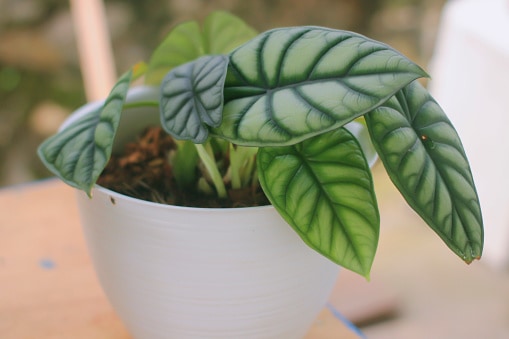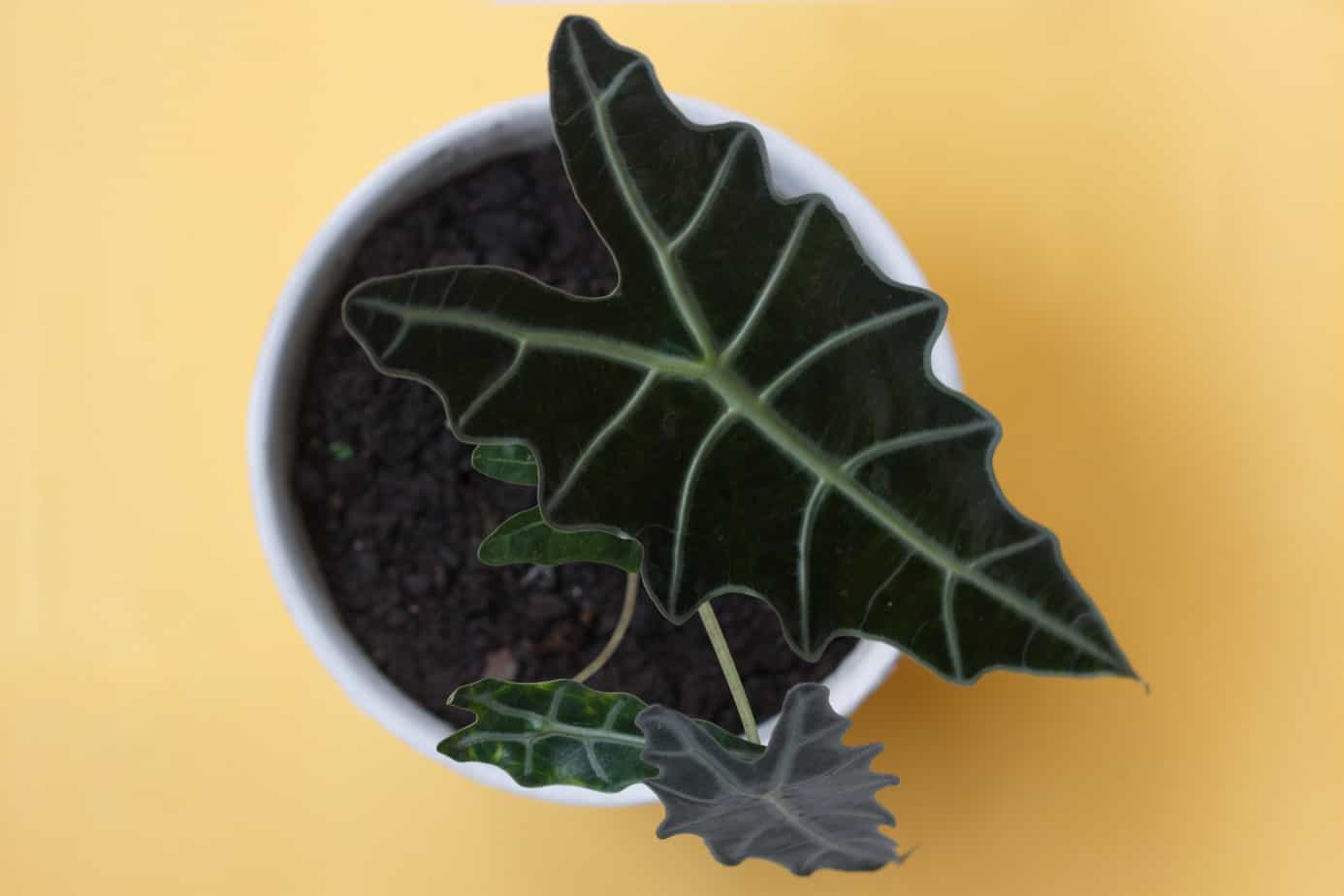No products in the cart.
Alocasia plants are among those highly coveted indoor gems that would certainly have you gushing over them. And it’s worth it!
What is the Alocasia Silver Dragon?

Alocasia silver dragon (Alocasia baginda), also known as ‘Jewel Alocasias and ‘Elephant Ear Silver Dragon’ is a member of the exotic few species that belong to the plant family Araceae.
Alocasia silver dragon is a variety from at least 97 species of the genus plant characterized as rhizomatous or tuberous and broad-leaved herbaceous perennials.
They are native to Borneo and some parts of subtropical Asia and Eastern Australia and thrive abundantly from the grounds of tropical rain forests.
The silvery broad-leaved plant grows to about 1.6 feet tall, with its foliage reaching a length of 6 inches and a width of about 3 inches or so.
How to Care for Alocasia Silver Dragon Plant?

Alocasiasilver dragon certainly lives up to its name. With that kind of intricately textured silvery foliage that resembles dragon scales, these exotic plants will certainly give your home a mystical touch!
With that being said, Plantly is here to guide you with the do’s and don’ts of caring for your lovely alocasia silver dragon, whether it’s indoors or in your garden.
Check this table below for Silver Dragon’s quick requirement:

Best Potting Mix for Alocasia Silver Dragon
A well-draining soil incorporated with mulch and perlite is an ideal combination for your Alocasia plants. Keeping the soil evenly moist but not too wet is your goal, and this is particularly important when choosing the right medium.
Moreover, a soil mix with lots of organic matter will surely make your plants happy. So go ahead and run the extra mile by tossing in some other soil amendments such as peat moss, coco coir, and garden compost. This will not only harbor good bacteria in the soil for better growth but will also improve soil texture and drainage.
Ideal Lighting for Alocasia Silver Dragon

Most Alocasia species would prefer to live in a room receiving an ample amount of natural light, but a medium to bright indirect light would be the most ideal.
It’s important to choose a strategic location where the plant would not be subject to any direct sunlight as this may damage and scorch the silvery leaves. We certainly don’t want that!
You may be able to find the right balance for your Alocasia silver dragon by placing them on the west or east-facing window.
Watering Needs of Alocasia Silver Dragon
Spring to Autumn is usually the period with which there is extensive growth. At this time, a watering frequency of two to three times a week is observed. Note, however, that the kind of medium with which your plant grows also determines how much water you should give them. If the soil appears to be more clayey and heavy, you may have to water it less often.
Alocasia silver dragon likes to have adequate moisture in the air but is quite sensitive to waterlogged conditions and thus soggy soil is no good. Hence the use of a moisture meter may help you determine the precise level of dryness for your soil.
While inadequate watering may also prove harmful, it’s still best to make sure that your Alocasia silver dragon is not overwatered. Hence water them only once the top two inches of the soil feels dry to the touch.
Temperature & Humidity
The Silver Dragon prefers a warm and humid place. So a temperature range between 55 °F– 80 °F (13 °C to 27 °C) is where they would optimally thrive. However, the plant can also withstand high temperatures of up to 95 °F, but watering should be consistent and they should not be receiving harsh sunlight.
You may be able to keep the plant outdoors throughout spring and summer, but be sure to take them indoors once fall arrives and temperatures start dropping below 60 °F.
When growing them indoors, make sure the temperature would not drop below 55 °F because low temperatures lead to slower metabolism rates, hence slower growth.

Given their subtropical origin, warm temperatures are a must and so is the atmospheric humidity of at least 60 – 80 %. You can maintain a good humid level by occasional spraying or misting, use of a humidifier, or setting up of pebble tray.
Hardiness zone 9 to 11 is suitable for the outdoor growth of Alocasia, but if grown in an indoor garden, the plant can do well in USDA Zones 4 to 11.
Fertilizing Alocasia Silver Dragon
Alocasias are best fertilized on a bimonthly schedule. Fertilizers with a fair amount of nitrogen would greatly benefit this foliage plant, especially during the growing season.
But aside from N fertilizers, you may also use bone meal fertilizers to mimic the calcium-rich substrates where they would usually thrive in their native island of Borneo. In most plants, calcium plays a role in disease resistance and in providing structural support by promoting cell growth.
Refrain from using cheap fertilizers, as they tend to accumulate in the soil-forming crystals which can potentially be harmful to your plants.
Propagation of Alocasia Silver Dragon
To propagate Alocasia silver dragon, you need an adult plant that produces small plantlets that you can separate and transplant to new terracotta pots, or the ones with drainage holes.
In addition, Alocasias can produce bulbils that can later be separated to use as propagating material. If you are working on bulbils, be sure to use a moist potting mix with a balanced combination of peat and perlite. In just a couple of weeks, you may notice that the bulbils are beginning to sprout.
You can also use root cuttings that are produced through root clump division using a sterile knife. Expect that each of these divisions would grow into an individual plant and needs to be cared for. At this time it’s crucial to maintain a warm ambient temperature surrounding the new plant and to never let the soil dry out completely.
Alocasia Silver Dragon Varieties and Other Similar Plants
Alocasia Dragon Scale

While the Alocasia dragon scale and Alocasia silver dragon shares a lot of similar features, the alocasia dragon scale is much greener and tougher. The shimmering and textured foliage with dark green venation is so visually satisfying. Plus they are said to be the easiest to rear among other alocasia plants.
The plant thrives in a moist potting mix and a temperature range of 55-80°F (13-27°C) under bright indirect light or dappled shade.
Alocasia Amazonica ‘Polly’

The most popular of the Alocasia genus, Amazonica Polly is a compact hybrid plant that features large, dark-green, arrow-shaped leaves. These narrow leaves have wavy edges, thick white veins, and an abaxial portion in the shade of burgundy.
This special plant grows up to 18-inches tall and the leaves span at about 16 inches long. Use a porous potting mix rich in organic matter. Water weekly and mist from time to time.
Alocasia macrorrhizos ‘Giant Taro’

As the name implies, Alocasia ‘Giant Taro’ is the largest Alocasia variety. It is also referred to as the ‘Upright Elephant Air.’ The plant is characterized by its glossy, lime-green foliage with an astonishing length of at least 3 – 5 ft. Their erect stature proves to be convenient for an indoor plant.
Alocasia Silver Dragon Diseases & Pests
While prevention is always better than the cure, knowing the first signs of disease and infestation may help in effectively addressing the problem. Early diagnosis leads to early treatment. Some of the most common diseases and pests that may pose problems to your alocasia silver dragon are listed as follows:
Leaf Edema
This can be identified with diseased leaves having damp, waterlogged blotches. The main culprit, as you may have guessed, is overwatering. When this symptom appeared, carefully remove the affected plant and change the soil to a much loose and aerated mix. Observe the abovementioned watering frequency.
Root Rot
Sudden wilting and drooping of leaves are the most common symptoms of root rot. This may also be caused by overwatering and a clayey medium. Unfortunately, the only way to confirm this is to uproot the whole plant.
If the root system appears brown and slushy, then there’s not much you can do. See if there are any plantlets that you can save and repot to a better medium. A healthy plant has white and firm roots.
Yellowing of the Leaves or Chlorosis
Yellowing or chlorosis is a general symptom that may either be caused by a disease or nutrient deficiency. It usually starts with the lower leaves first, before spreading all throughout. Commonly associated with salt buildup due to over-fertilization.
To make sure that excess fertilizers are leached out, water the plant deeply in every cycle allowing the water to completely drain out each time.
Spider Mites and Caterpillars
Alocasia plants are reportedly susceptible to spider mites. As they feed on the plant, they usually leave leaf spots and openings that may become a gateway for a fungal and bacterial infection to occur.
Caterpillars, on the other hand, are associated with cheese holes that are usually seen on leaf edges. This is aggravated by exposure to cold temperatures and sudden warm drafts.
Control pest occurrence by keeping the humidity level above 70 %. If the infestation persisted, go by natural means. Use neem oil and apply to the plant once a week for two to three weeks.
Frequently Asked Questions
Alocacia Silver Dragon is a very rare plant. Highly coveted due to their light, silvery-green leaves with dark green veins, and a texture similar to that of dragon scales.
Yellowing may be a sign of either a disease caused by overwatering since the plant is sensitive to wet soil, or salt accumulation caused by improper fertilization.
Alocasias are fast growers, even if they tend to quickly drop their leaves, they are fast to replace it with new ones. During the summer season, induce your plant to actively push out new leaves and grow larger ones by placing it on a spot that receives plenty of indirect bright light.
Now that you’ve learned all the basics of caring for alocasia silver dragon, there’s no other place where you can get a hold of the best quality rare plant other than here in Plantly!
Whether you want to buy, sell or simply reach out to other plant enthusiasts, Plantly is the right place to be!


